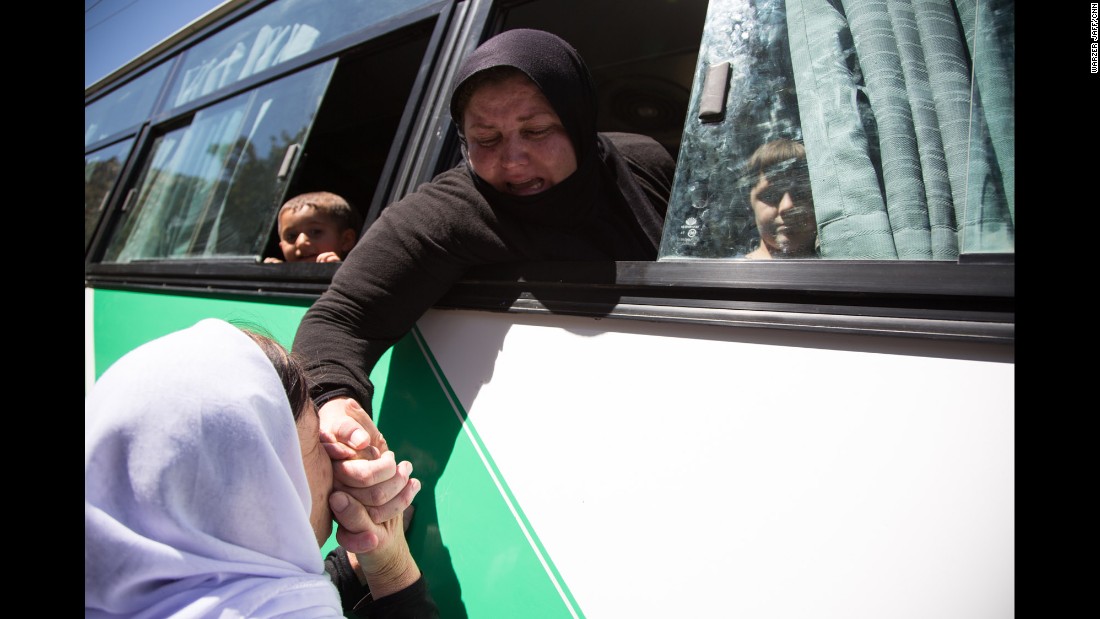
Lalish Temple, Iraqi Kurdistan – “Goodbye,” a woman dressed in a black shawl murmured in Kurdish, as she kissed the outstretched hand of an elderly cleric.
“Pray for me,” said the next woman in line, as she bowed her head and kissed the old priest’s hand.
This was a farewell ceremony for 66 women and children who had all been former captives of the armed Islamist movement known as ISIS.
Most of those gathered here suffered unspeakable crimes at the hands of the jihadi militants. And all of the victims were Yazidis, members of an ancient ethnic and religious minority whose future in Iraq is now in question.
In the courtyard of the centuries-old Lalish Temple, next to an archway decorated with stone carvings of the sun, the moon, and a yard-long black snake, Baba Sheikh — the spiritual leader of the Yazidis — leaned on a cane as he gave a final blessing to the congregation.
The women shrouded in the black color of mourning and their children would soon travel to Germany, where they were being offered refuge, psychological support and an escape from the horrors of war in Iraq.
“What ISIS did to you, will not happen again,” said the Yazidi patriarch, who was dressed in flowing white robes and wore a long white beard.
“Stop wearing black,” he urged the gathered women. “The black clothes will only remind us of the destruction of our villages and all the bad things that happened to us.”
Historic persecution
Modern-day Iraq is the traditional homeland of the Yazidis, an ancient religious group believed to pre-date both Christianity and Islam. The faith’s roughly 600,000 members are taught that for centuries, they have been persecuted by the majority Muslim population that surrounds them.
Yazidi leaders often say their community suffered 73 massacres and genocides.
On several occasions, Muslim conquerors overran the Lalish Temple, the holiest site in the Yazidi faith, turning it temporarily into a Muslim school.
More recently, a series of horrific suicide truck bombings targeted a group of Yazidi villages in Iraq’s nearby Sinjar province, killing more than 300 people in 2008.
But few could have predicted the ferocity of the assault launched by ISIS against the Yazidis in Sinjar in August of 2014.
The militants’ lightning-fast conquest of the province triggered an exodus, as hundreds of thousands of people fled their homes. Yazidi groups and the Kurdistan Regional Government have documented the deaths of at least 3,000 Yazidi civilians at the hands of ISIS, as well as the kidnapping of more than 5,000 Yazidis — most of whom were women.
Modern-day slavery
ISIS considers Christians and Jews to be “people of the book:” religions recognized and respected in the Koran. But the movement detests the Yazidis, who are considered to be apostates. In fact, ISIS proudly revived a detested practice as punishment for the Yazidis, imposing a modern-day version of slavery on its Yazidi prisoners.
Several former female captives have described to CNN how they were bought and sold as human property over the last year.
“ISIS found some verses in the Koran to justify modern day slavery,” explained Mamo Othman, a Yazidi and former minister of the Iraqi Government, who now teaches at the University of Duhok in Iraqi Kurdistan.
“ISIS has taken us back 1,400 years,” Othman said.
“We are all traumatized now,” said Myrza Dinnayi, a Yazidi advisor to the Kurdistan Regional Government. Dinnayi said he had interviewed more than a thousand Yazidi women who escaped after being held by ISIS. Nearly all of them had been subjected to repeated sexual assault. Many of them, they were sex slaves under ISIS captivity.
